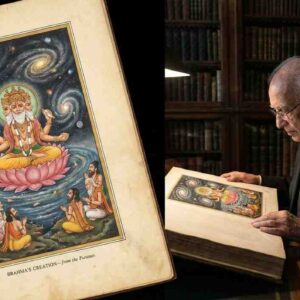A Reflection on Our Connection to Timeless Principles
Sanatan Dharma, often described as the eternal way of life, offers a philosophy that transcends time, emphasizing righteousness (dharma), compassion (ahimsa), and self-realization (moksha). Yet, in a world dominated by technology, consumerism, and fleeting trends, one pressing question emerges: Are we truly embracing these values in our daily lives, or are they being relegated to ceremonial gestures and rhetorical debates?
This exploration examines the relevance of Sanatan values today, addressing whether our lifestyles align with the timeless principles that define this spiritual and ethical tradition.
1. Dharma vs. Daily Dilemmas
- Principles in Conflict: The concept of dharma emphasizes righteous living, balancing personal duties with societal harmony. However, the increasing prevalence of corruption, materialism, and self-centered behavior challenges its application.
- Bhagavad Gita Insight: Krishna’s counsel to Arjuna highlights the importance of performing duties selflessly, a practice often overshadowed by modern-day pursuits of individual gain.
- Example: Ethical dilemmas in professional settings often see individuals prioritizing profit over principle, diluting the essence of dharma.
2. Ahimsa in an Aggressive World
- Non-Violence in Thought and Action: While ahimsa (non-violence) is a cornerstone of Sanatan Dharma, our actions often contradict this value. From online hate speech to environmental exploitation, the practice of compassion remains largely theoretical.
- Digital Disharmony: Social media platforms have become battlegrounds for ideological conflicts, reflecting how far we have strayed from ahimsa in communication.
- Environmental Exploitation: Our disregard for nature and unsustainable practices highlight a failure to extend ahimsa to the planet, despite Sanatan teachings emphasizing harmony with the environment.
3. Moksha: The Forgotten Goal
- Spiritual Liberation Amid Material Desires: Sanatan Dharma views moksha—liberation from the cycle of birth and rebirth—as life’s ultimate goal. Yet, in today’s material-driven society, spiritual aspirations are often overshadowed by the pursuit of wealth, power, and status.
- Modern Perspective: Meditation and mindfulness, rooted in Sanatan traditions, are increasingly marketed as wellness trends rather than paths to self-realization.
- Disconnect: The commercialization of spirituality reflects a shift away from the authentic pursuit of moksha, reducing profound practices to superficial rituals.
4. Rituals vs. Values
- Performative Practices: While rituals remain an integral part of Sanatan Dharma, their deeper meanings are often overlooked. Festivals, fasts, and prayers risk becoming performative rather than transformative.
- Example: The lighting of lamps during Diwali symbolizes the triumph of light over darkness, yet consumerism often takes center stage, overshadowing the festival’s spiritual significance.
- The Need for Introspection: True adherence to Sanatan values requires understanding the purpose behind rituals and integrating them into daily life, beyond mere ceremony.
5. Inclusivity and Community
- Vasudhaiva Kutumbakam: The Sanatan ideal of “the world is one family” promotes inclusivity and universal compassion. However, divisive ideologies and rigid interpretations of tradition challenge this ethos.
- Contemporary Contradictions: Political and social divides often exploit religious identities, diluting the inclusive spirit of Sanatan teachings.
- Reviving Unity: Embracing diversity and fostering dialogue are essential to realigning with the values of harmony and oneness.
6. The Youth Disconnect
- Generational Gap: Younger generations often perceive Sanatan values as archaic or irrelevant, leading to a widening disconnect.
- Cultural Miscommunication: The emphasis on rigid adherence to tradition, without contextualizing its relevance, alienates many young individuals.
- Reinterpretation Needed: Efforts to bridge this gap must focus on presenting Sanatan principles as adaptable, empowering, and aligned with contemporary challenges.
7. Environmental Ethics
- Reverence for Nature: Sanatan Dharma’s teachings emphasize living in harmony with the environment, viewing nature as sacred. However, rapid industrialization and environmental degradation reflect a departure from these values.
- Sustainable Practices: Ancient principles of conservation, such as sustainable agriculture and water preservation, remain relevant but are often ignored in modern lifestyles.
- Hopeful Movements: Eco-friendly celebrations and green initiatives inspired by Sanatan teachings offer glimpses of a revival in environmental ethics.
Conclusion: Reviving the Eternal Way
Sanatan Dharma is not merely a set of rituals or philosophical musings; it is a guide for living a balanced, ethical, and spiritually fulfilling life. However, the divergence between these values and modern practices underscores the need for introspection and realignment.
The challenge lies in translating timeless principles into actionable guidance for contemporary life. By embracing the essence ofdharma,ahimsa, andmoksha, and fostering inclusivity and sustainability, we can honor the legacy of Sanatan Dharma while ensuring its relevance for future generations.
The question remains: Are we truly embodying the spirit of Sanatan Dharma, or are we letting its profound wisdom slip away into ceremonial formalities and hollow practices? The answer lies in our willingness to live these values, not just celebrate them.












